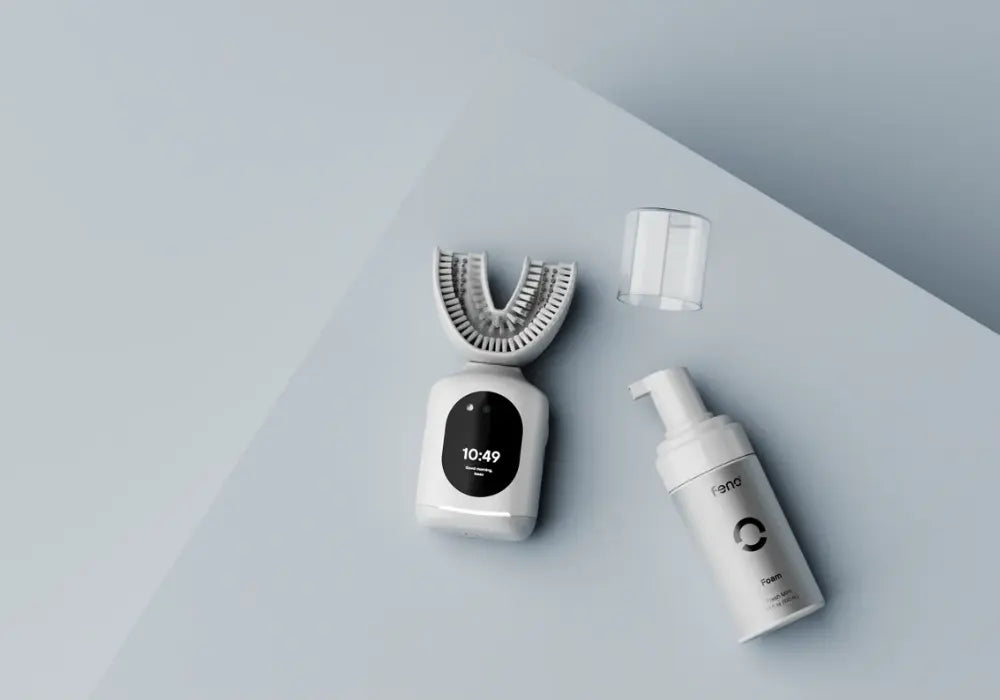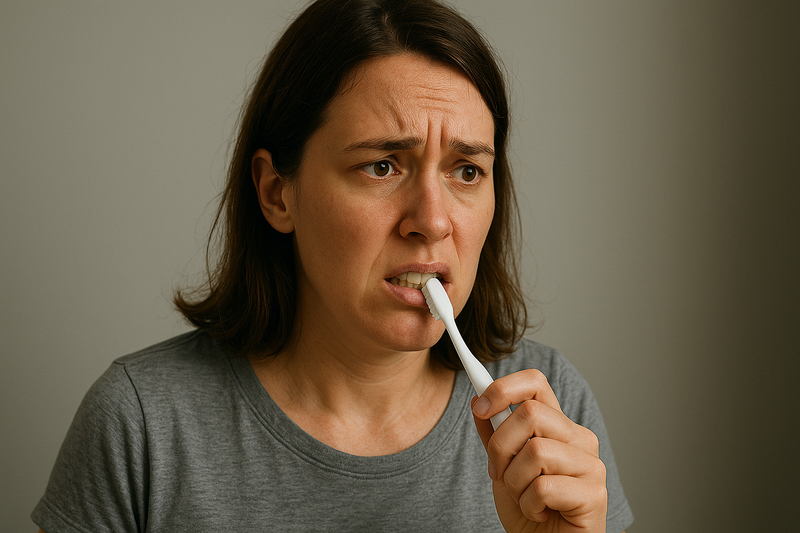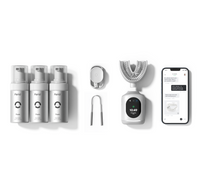
11 min read
The Ultimate Oral Health Transformation: A Closer Look at Sonic Toothbrushes
Essential Takeaways
- Sonic toothbrushes use high-frequency vibrations and ultrasonic technology to agitate fluids, disrupting plaque and reaching hard-to-clean areas.
- They enhance oral hygiene by improving fluoride distribution, stimulating saliva production, and preventing tartar buildup.
- Integrated features—timers, pressure sensors, and AI-driven feedback—optimize brushing techniques while protecting gums and enamel.
- Ergonomic designs with customizable modes ensure thorough cleaning, even in hard-to-reach spots, benefiting sensitive teeth.
- This innovative approach transforms daily brushing into an effective, efficient, and personalized dental care routine.
Sonic toothbrushes are transforming the way we maintain dental hygiene, offering a blend of innovative technology and user-friendly features. These operate on sonic toothbrush technology, which utilizes high-speed vibrations to agitate fluids around the teeth and gums, reaching areas that traditional brushes often miss. This advanced cleaning technique improves oral health and makes daily brushing more efficient and effective. The ability to penetrate hard-to-reach spots ensures a thorough cleaning, setting the foundation for healthier teeth and gums.
Understanding Sonic Toothbrush Technology
High-Frequency Vibrations
They distinguish themselves through their high-frequency vibrations, capable of producing thousands of movements per minute. This rapid action facilitates a more comprehensive cleansing by agitating the saliva and toothpaste into microbubbles that penetrate deep between teeth and along the gum line. The result is a remarkably effective removal of food particles and plaque, which are often missed by conventional brushing techniques. The efficiency of this technology ensures that every brushing session contributes significantly to oral health, reducing the time needed to achieve clean teeth.
The Role of Ultrasonic Technology in Plaque Removal
Ultrasonic vibrations are fine and intense, capable of disrupting plaque colonies on the teeth and beneath the gum line without harsh physical scraping. This gentle yet powerful cleaning method is particularly beneficial for individuals with sensitive gums or those prone to dental erosion. By utilizing ultrasonic waves, sonic toothbrushes offer a preventive approach to dental care, maintaining the integrity of enamel and gums.

Sensors, Timers, and Feedback
Smart sonic toothbrush features elevate the brushing experience by integrating sensors, timers, and real-time feedback mechanisms. These components work together to guide users through optimal brushing habits. Pressure sensors ensure that users do not damage their gums and enamel by brushing too hard, while timers help maintain the dentist's recommended two minutes of brushing time. Feedback systems often connect to mobile apps, providing users with detailed insights into their brushing patterns and areas that need more attention, thus personalizing the dental care routine.
Electric vs. Sonic Toothbrushes
While all electric toothbrushes offer motorized brushing actions, Sonic ones use sound waves to create additional cleaning effects. The sonic motion generates a secondary cleaning action that helps fluids flush out food particles and plaque beyond the reach of bristles alone. This capability makes Sonic toothbrushes more effective, particularly in maintaining gum health and preventing periodontal disease.
The Sonic Toothbrush Advantages
Enhance Gum Health
Utilizing a sonic toothbrush for gum health can lead to significant improvements. The gentle yet effective sonic vibrations are less abrasive on the gums than manual brushing, which often causes irritation or damage when done too vigorously. Massaging the gum line stimulates blood flow and helps reduce inflammation, which is crucial in preventing gum diseases. Regular use of these toothbrushes can lead to healthier, firmer gums and a reduction in the symptoms associated with gum disease, such as bleeding or swelling.
Cleaning for Hard-to-Reach Areas
The design targets the elimination of plaque and food debris from hard-to-reach areas between teeth and along the gum line. The extended reach of the brush heads, combined with the sweeping motions of the bristles powered by sonic vibrations, ensures that every crevice and contour of the mouth is accessed. This thorough cleaning is especially beneficial for those with braces, dental bridges, or crowns, where traditional brushing methods often fall short.
Benefits of Ultrasonic Toothbrushes
Dentist-recommended toothbrushes often include ultrasonic models because of their proven effectiveness in oral hygiene management. These toothbrushes reduce plaque buildup more efficiently, which can lead to more serious dental issues if untreated. The high-frequency vibrations break up plaque even before it solidifies into tartar, making professional cleanings easier and less frequent.
How Sonic Vibrations Help Prevent Cavities and Decay
In today’s rapidly evolving oral care technology, sonic toothbrushes have emerged as revolutionary tools beyond simple cleaning. They harness high-frequency vibrations to elevate dental hygiene practices:
- Increased Fluoride Distribution: As the sonic vibrations create rapid fluid movement, fluoride particles are dispersed more uniformly, ensuring that every nook and cranny of the enamel receives protective coverage. This widespread distribution enhances the enamel's resistance to acid attacks and decay. The constant motion helps the fluoride penetrate into microscopic crevices, reinforcing the enamel structure and facilitating a deeper, more effective bond with the tooth surface. Moreover, by evenly spreading fluoride, sonic toothbrushes maximize the toothpaste’s potential to remineralize weakened areas and repair early signs of decay before they progress into cavities. The dynamic environment created by the vibrations also minimizes the chance of fluoride being washed away by saliva, extending its protective action. Over time, this results in more resilient enamel and a reduced likelihood of decay formation.
- Stimulation of Saliva Production: Saliva is a natural defender of oral health, acting as a buffer against acids produced by bacteria and assisting in the remineralization of enamel. When sonic vibrations are applied during brushing, they gently massage the oral tissues, which can trigger the salivary glands to secrete more saliva. This increased saliva flow is beneficial because it helps neutralize the acidic environment bacteria create, reducing the risk of enamel erosion and decay. In addition to its buffering capacity, saliva contains essential minerals such as calcium and phosphate that are crucial for repairing microscopic damage to the enamel. The cumulative effect of these processes means that regular use can lead to a consistently healthier mouth, where natural defenses are reinforced, and the likelihood of cavities and decay is significantly minimized.
- Prevention of Tartar Formation: Tartar forms when plaque remains on the teeth for an extended period, allowing minerals from saliva to harden it into a rough, adherent layer that conventional brushing struggles to remove. Sonic vibrations disrupt this process by effectively removing plaque before it has the opportunity to calcify. The high-frequency oscillations break apart the plaque matrix, reducing the time it has to mineralize and form tartar deposits. Additionally, the enhanced fluid dynamics in the mouth aid in washing away loose plaque particles, preventing them from settling on the tooth surfaces. This continuous removal of plaque is essential for maintaining a smooth enamel surface and protecting the gums from irritation and infection.
- Reduction of Gingival Inflammation: By targeting the delicate area where the teeth meet the gums, these devices help to prevent the accumulation of bacteria that can lead to irritation and infection. This reduction in inflammation is crucial because inflamed gums are more susceptible to developing periodontal disease, which can ultimately compromise the tooth roots and supporting structures. The continuous agitation of fluids in the mouth during brushing assists in flushing out irritants and maintaining a healthier environment around the gums. Consistent use results in healthier, more resilient gum tissue, which is better able to support the teeth and prevent the progression of periodontal issues.
Embracing the capabilities of sonic vibrations in daily oral care routines promises a proactive approach to maintaining dental health and achieving a brighter, healthier smile.

Innovative Sonic Toothbrush Features and Design
The Importance of Ergonomic Designs
Innovative design is a hallmark of modern sonic toothbrushes, particularly evident in the ergonomic and u-shaped toothbrush designs that cater to user comfort and effectiveness. Ergonomic handles are crafted to fit comfortably in the hand, reducing strain during brushing sessions, which is especially beneficial for individuals with limited mobility or dexterity. Meanwhile, U-shaped brush heads are designed to surround the teeth thoroughly, allowing the sonic vibrations to clean multiple surfaces simultaneously.
Customizable Brushing Modes
These settings allow users to adjust the intensity and speed of the vibrations, catering to conditions like sensitive teeth, gum care, or whitening desires. The personalization of brushing experiences improves comfort and maximizes oral hygiene effectiveness by tailoring the session to specific dental needs, ensuring that users receive the most appropriate care for their unique dental health situations.
The Integration of AI and Real-Time Brushing Feedback
AI algorithms analyze brushing data collected over time to offer customized suggestions for improving brushing techniques and routines. Real-time feedback delivered during brushing sessions helps users adjust their movements and pressure instantly, leading to better cleaning results. A proactive approach to dental care, facilitated by AI, empowers users to maintain optimal oral health through precise and informed brushing.
How to Optimize Your Brushing Routine with a Sonic Toothbrush
Proper Brushing Techniques
When using a sonic toothbrush, the goal is not just to clean the teeth's surfaces but also to maintain overall oral health by ensuring thorough plaque removal and gum stimulation. Here are several key techniques:
- Angle the Brush: Holding the toothbrush at roughly a 45-degree angle toward the gum line enables the high-frequency vibrations to penetrate the small crevices where plaque accumulates. This specific angle ensures that both the tip of the bristles and their ultrasonic motion work together to gently sweep along the gum margin, dislodging bacteria and food particles that might otherwise cause inflammation or decay. Maintaining the ideal angle also helps minimize the formation of pockets along the gum, which can harbor pathogens over time. The effective contact between the bristles and the tooth-gum interface results in a more comprehensive cleaning process. In addition, this method aids in stimulating the gum tissue, promoting better circulation, and helping to reinforce the structural integrity of the periodontal tissues. As you practice this technique, it is important to remain mindful of your hand position, adapting as necessary to cover variations in dental architecture.
- Gentle Pressure: This approach minimizes the risk of irritation, wear, or damage to sensitive gum tissues and enamel, which can result from overzealous brushing. A relaxed hand allows the brush to glide along the contours of your teeth and gum line, ensuring an even distribution of cleaning energy and reducing the chance of uneven wear or recession. By letting the technology do its work, you safeguard your oral tissues and optimize the removal of debris and bacteria. Adjusting your brushing habits to incorporate minimal pressure also trains you to be more mindful during your daily routine, fostering a more relaxed and practical approach to maintaining dental health.
- Cover All Areas: To truly benefit from this technology, it is crucial to methodically cover the outer, inner, and chewing surfaces of each tooth during every brushing session. This inclusive approach ensures that areas often neglected—such as the lingual surfaces behind the front teeth or the intricate crevices on molars—are not left vulnerable to plaque buildup. Adhering to a systematic pattern allows the vibrations to be distributed uniformly, disrupting plaque wherever it forms and preventing the onset of decay. Employing a technique that divides your mouth into quadrants can be particularly effective; it ensures that no single region is over- or under-cleaned. This practice not only improves the immediate cleanliness of the mouth but also builds a long-term barrier against bacteria and decay.
- Focus on Hard-to-Reach Areas: An essential aspect of proper brushing is dedicating extra attention to those parts of your mouth that are easily overlooked, such as the back molars, areas near dental work, and spaces where the toothbrush might struggle to reach. Concentrate on angling the brush to navigate around dental fixtures like crowns, fillings, and bridges, where plaque can accumulate unnoticed. These areas are often more susceptible to decay due to limited accessibility during routine cleaning. By taking additional time to direct the sonic energy to these regions, you maximize the removal of bacterial buildup and food particles that can lead to cavities. Incorporating this method into your brushing routine helps to break down plaque in places where traditional techniques might fall short, ensuring a more uniform cleaning process throughout your mouth.
- Brush Twice a Day: Brushing in the morning removes the overnight accumulation of bacteria and sets a positive tone for the day, while brushing before bedtime cleanses away food particles and plaque built up throughout the day. This regular schedule mitigates the risk of cavities and decay and supports overall gum health by reducing the likelihood of inflammation and periodontal issues. With their advanced vibration technology, sonic toothbrushes ensure that even brief brushing sessions are highly efficient, delivering a thorough cleaning that traditional methods may not match. Committing to this twice-daily routine reinforces a consistent habit that safeguards your teeth against the daily challenges of bacterial colonization and acid erosion.
Proper brushing techniques play a vital role in harnessing the full potential of sonic toothbrush technology. You establish a robust oral care regimen by focusing on the strategies discussed.
Common Mistakes to Avoid
Avoid using it like a manual toothbrush by scrubbing back and forth; instead, let the vibrations do the work. Another mistake is not changing the brush head regularly; worn bristles decrease the toothbrush's effectiveness. Skipping sections of your mouth or not using the timer feature can lead to inconsistent cleaning, leaving some areas more prone to plaque buildup than others.

The adoption of sonic toothbrushes markedly enhances the journey towards achieving optimal oral health. These devices offer a comprehensive approach to dental care that surpasses the capabilities of traditional brushing methods. Their ability to deliver deep cleaning through high-frequency vibrations allows for oral hygiene that is difficult to achieve with manual brushes. As we continue to witness technological advancements in this field, sonic toothbrushes are a pivotal tool in maintaining dental health and preventing future oral health issues.
Share




